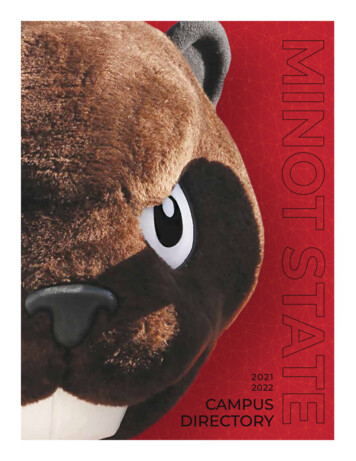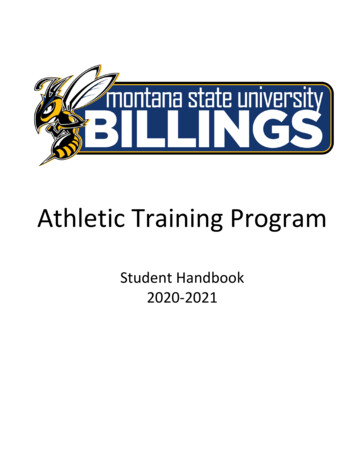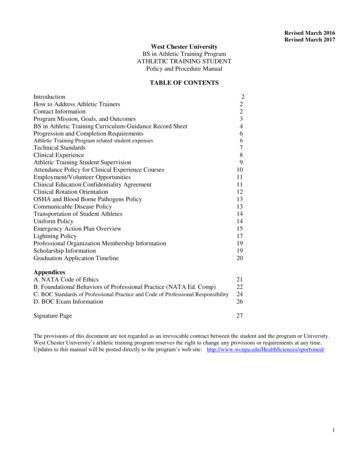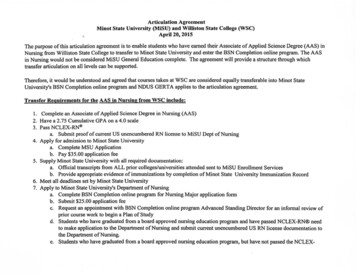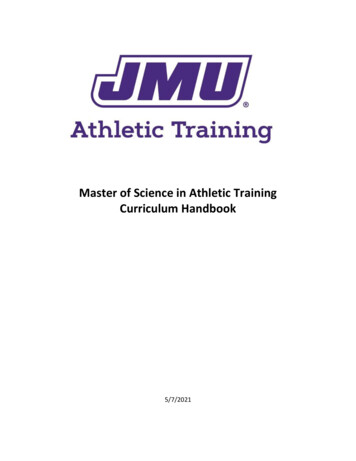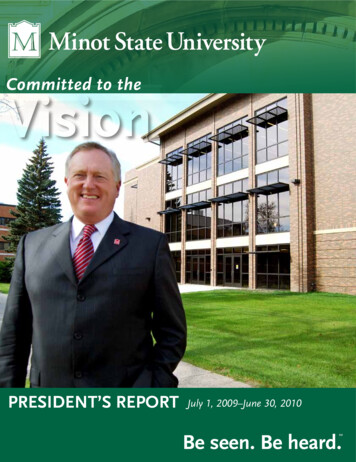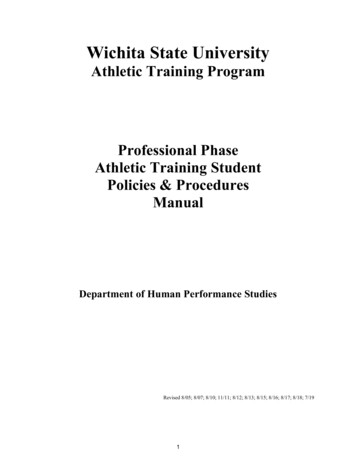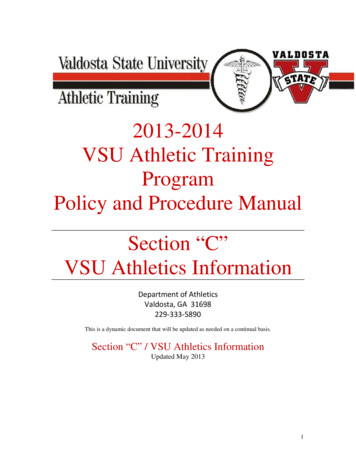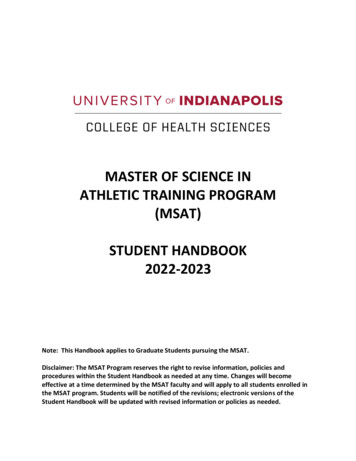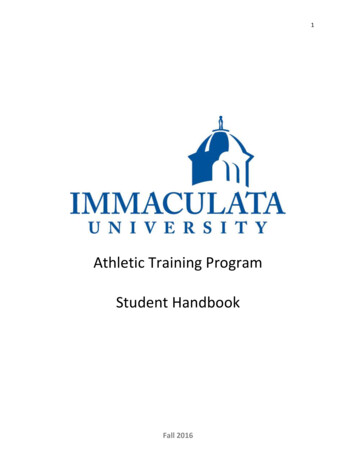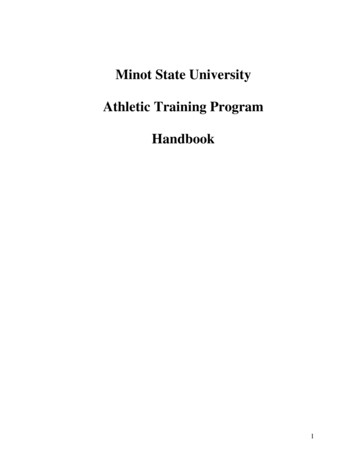
Transcription
Minot State UniversityAthletic Training ProgramHandbook1
Table of ContentsDescription of the Institution .4Description of the TEK Program .4Description of the Students .5Description of the Program .5Program Mission and Goals .5Student Agreement Statement.6Section One: Academic Requirements .7Program Admission Prerequisites and Procedures . 8-9Immunization Requirements .9Transfer Student Policy .13Professional Rescuer CPR/AED Training .13OSHA/Blood borne Pathogens Training .14Significant Infectious Diseases Policy .14Expenses .16Technical Standards for Admission. 17-18Travel Policy .18Clinical Supervision Policy .18Program Requirements .19Academic Curriculum . 19-25Clinical Education . 26-28Responsibilities of the Student Mentors .28Section Two: National Athletic Trainers’ Association .29NATA Certification .30NATA Code of Ethics . 31-32Section Three: Policies and Procedures .33Criteria for Retention in the Athletic Training Program .34Athletic Training Probation/Disciplinary Policy . 34-35Procedure for Re-admittance to the ATP .35Athletic Training Student Policies and Procedures .36Athletic Training Facility Daily Procedures.37Athletic Training Dress Code .38Athletic Training Facility Policies and Procedures for Athletics . 39-40Taping Policy.41Section Four: Athletic Training Domains and Competencies .42Assessment Tracking .42Section Five: Injury Assessment Checklist .43Evaluation Checklist . 44-70Ankle Evaluation Checklist . 44-45Knee Evaluation Checklist . 46-48Hip Evaluation Checklist . 49-51Hand Evaluation Checklist . 52-54Neck and Cervical Spine Evaluation Checklist . 55-56Down Athlete Evaluation Checklist . 57-58Cardiovascular Evaluation Checklist .592
Table of Contents ContinuedBack and Pelvis Evaluation Checklist . 60-61Shoulder Evaluation Checklist . 62-64Elbow Evaluation Checklist . 65-66Shoulder Pad Fitting .67Football Helmet Fitting .68Crutch and Cane Fitting.69ADDENDUM .70Trinity Sports Medicine Dress Code .70Trinity Hospital and Clinics Dress Code .71Trinity Health Requirements to Attend Clinical Sites .74Student Health Information and BBP Exposure Protocol .75MSU ATP Non-Discrimination Policy .76Minot State University Athletic Training Program’s Policy on how credit hours aregranted for courses that incorporate clinical experiences. .76MSU ATP Employment Policy .76Athletic Training Program Student Athlete Policy .773
Description of the InstitutionMinot State University is the third largest university in the North Dakota UniversitySystem. Minot State University is located in Minot, a city of over 46,000 residents. MinotState University is located in the north central region of North Dakota. Minot StateUniversity draws its’ student population from all over the nation and has a large populationof Canadian students. Minot’s trade and commerce is comprised of the urban residents, theMinot Air Force Base located 12 miles north of the city, and the rural residents of the region.Minot State University resides on 102 acres of land that provide ample opportunitiesfor student interaction and an inviting atmosphere. The campus is comprised of over 20buildings for student living, learning, and life. The University’s seven classroom buildingsare centrally located between the five residence halls, the library and the arts and athleticvenues. Minot State University employs over 400 people to accommodate student life. Thecampus organization provides students with a campus life that is student-centered and wellrounded.The Department of Teacher Education and Kinesiology is looking to seize theopportunity to enhance its programming by offering an Athletic Training Program. Studentswho wish to become certified athletic trainers must take the national certificationexamination offered by the Board of Certification. The Board of Certification requires thatexam candidates graduate from an education program that is accredited by The Commissionon Accreditation of Athletic Training Education. Minot State University was accredited theCAATE in 2012. The Athletic Training Program allows students that attend Minot StateUniversity the opportunity to major in athletic training.Description of the Teacher Education and Kinesiology ProgramThe Teacher Education and Kinesiology Department offers degrees in physicaleducation, corporate fitness, and athletic training. The National Athletic Trainers’Association states that students are to be educated in the following areas human anatomy,human physiology, exercise physiology, kinesiology/biomechanics, nutrition, statistics andresearch design, strength training and reconditioning, acute care of injury and illness, riskmanagement and injury/illness prevention, pathology of injury/illness, assessment ofinjury/illness, general medical conditions and disabilities, therapeutic modalities, therapeuticexercise and rehabilitation, health care administration, weight management and bodycomposition, psychosocial interventions and referral, medical ethics and legal issues,pharmacology, and professional development and responsibilities. The Athletic Trainingmajor’s curriculum is responsible for providing classroom instruction, clinical education, andtracking of students’ progress using an outcomes-based approach. Minot State Universityalso has a close relationship with community schools and businesses that lend ampleopportunities for students to have real world work experience. The Kinesiology Program has5 full time tenure tract faculty that have diverse backgrounds in strength and conditioning,athletic training, physical education, business and industry.4
Description of the StudentsThe learner population at Minot State University is made up of North Dakotaresidence, military personnel or military dependents, and non-residents from numerous statesand countries. The diverse population of students enhances the educational opportunity forstudents at Minot State University.Description of the ProgramThe Athletic Training Program offers an undergraduate major for athletic training atMinot State University. The athletic training program will require 120 credits within themajor including the student’s general education courses. The courses are aligned with theCommission on Accreditation of Athletic Training Education standards and the AthleticTraining Educational Competencies set forth by the National Athletic Trainers’ Association.Program Mission and GoalsThe Minot State University Athletic Training Program’s mission is to providestudents with an educational experience that will allow them to successfully complete theBoard of Certification, Inc. exam. The Mission of the Athletic Training Program at MinotState University incorporates the University mission to advance knowledge, as well as thecritical and creative thinking skills of the Athletic Training Majors.Minot State University Athletic Training Program Goals1. To provide a comprehensive Athletic Training Program that will allow students tosuccessfully complete the Board of Certification, Inc. exam.2. To prepare competent Athletic Trainers who are involved in acting and reflecting onthe athletic training educational competencies and content knowledge that they haveacquired.3. To educate students on the National Athletic Trainers’ Association’s Code of Ethics.4. To provide students with the clinical and sideline skills required to successfullyperforming the duties of an Athletic Trainer.5
Student Agreement StatementI, (Student’s Name), agree to abide by the National Athletic Trainers’Code of Ethics and to present myself in a professional manner while I am in the AthleticTrainers Program at Minot State University. I understand that I am representing Minot StateUniversity’s Athletic Training Program and the Athletic Training Profession while I amattending events, practices, clinical experiences, conferences, and othereducational/competition settings. I understand the policies and procedures set forth by theAthletic Training Program and I by signing this form agree to the program policies andprocedures. I understand that not abiding by the NATA Code of Ethics, the policies andprocedures of the Athletic Trainer’s Program at Minot State University, or acting in a mannerthat reflects badly on Minot State University or the profession of Athletic Training may resultin disciplinary action.(Printed name of student)(Signature of Student)(Date XX-XX-XXX)6
Section One: Academic RequirementsProgram Admission Prerequisites and ProceduresImmunization RequirementsTransfer Student PolicyProfessional Rescuer CPR/AED TrainingOSHA/Blood borne Pathogens TrainingSignificant Infectious Diseases PolicyTechnical Standards for AdmissionTravel PolicyClinical Supervision PolicyProgram RequirementsAcademic CurriculumClinical EducationResponsibilities of the Student Mentors7
Program Admission Prerequisites and ProceduresStudent Application for Program Admission InformationStudents interested in the Athletic Training Major should meet with the Athletic TrainingProgram Director and enroll in ATR 128 Introduction to Athletic Training Course in the FallSemester. In Addition students should enroll in ATR 208, and BIOL 220 during their first year ofcourse work. Prospective students enrolled in the ATR 128 Introduction to Athletic TrainingCourse will be required to keep a journal that will be utilized for selection materials for theprogram. The journal is a reflection documentation of the observation hours spent in contact withan athletic trainer. The journal will contain information regarding the type of observation, thedates of observation, the times of the observation, signatures of the athletic trainer for theobserved dates, and a reflection on what occurred during the observations.The applicants will be ranked according to the information that was submitted in the ApplicationPacket in the following manner.1. ATR 128 Course Journal - 10 pts2. Grade Point Average - 20 pts20 pts. 3.81-4.012 pts. 2.74-2.6019 pts. 3.65-3.8011 pts. 2.59-2.5018 pts. 3.49-3.6410 pts. 2.49-2.017 pts. 3.33- 3.480 pts. less than 2.016 pts. 3.17 - 3.3215 pts. 3.01 - 3.1614 pts. 3.00-2.8113 pts. 2.80-2.753. Proof of First Aid/CPR Certification for the Professional Rescuer or Enrollment in KIN210 Prior to first clinical experience4. Immunization Documentation 5 pts5. Recommendations - 10 pts6. Written Goal Statement - 10 pts7. Technical Standards - 10 pts8. Interview - 10 pts9. Criminal Background ClearanceApplicants who submit the application requirements (1-7 above) and obtain a minimum of 42points out of the 65 points will be granted an interview with the Athletic Training ProgramSelection Committee (ATPSC), the ATPSC may grant interviews upon their discretion if the42/65 points are not met if the committee has a majority consensus on this topic. The ATPSCmay elect to conditionally admit a student to the ATP. Any student conditionally admitted to theATP will receive written notification on the stipulations for the conditional admittance withinstructions on what needs to be done to become fully admitted to the ATP. Students will beexpected to act and dress for a professional interview. All interviewed applicants will be rankedaccording to their cumulative scores on items 1-8 above. Applicants must a complete an FBI andNorth Dakota Bureau of Criminal Investigation (BCI) criminal background check. Refer to thesection titled Criminal Background Check for further information regarding the backgroundinvestigation. Background investigations take on average 4-5 weeks to be returned and therefor8
will be handed in after the admission notifications have been received by the students with thedates for criminal background check paperwork to be returned to the program director stated inthe admissions letter. Students will be tentatively admitted pending the Criminal BackgroundInvestigation results and given that the grade verification at the end of the semester meets thecourse grade/ grade point average requirements. The student’s tentative admission status willbecome full admission status based upon background investigation results and grade verificationat the beginning of the next semester. Up to ten students will be admitted each spring semester.The ATPSC has the authority to increase or decrease the number of applicants admitted based onthe number of preceptors available and the current enrollment in the Athletic Training Program.After the top ten applicants are ranked the remaining applicants will be listed as "alternates" forthe current semester. If for some reason one of the top ten ranked applicants does not take theirposition, the ATPSC may offer admission to the highest ranked student from the alternate list.Students will receive a letter regarding the admittance decision within 4 weeks after theinterview process.The application deadline is November 1st of each year.Program Admission Prerequisites and ProceduresPrior to admission students must complete and meet course admission and prerequisites.Students are required to submit proof of immunization with the course admission packet to theDirector of the Athletic Training Program. Student who choose not to take HBV immunizationsneed to provide in writing that they have chosen to decline HBV Immunization (by signing adeclination statement). At the current time there are no immunizations for hepatitis C and HIV.Students will be compliant with the influenza immunization policies of the agencies where attendingclinical. All students who decline a flu shot will sign a declination form which will be kept on file in theATP office. If a student declines vaccinations, they will be required to be compliant with the policies ofthe clinical sites non-vaccinated health care provider policy. Prior to beginning clinical experiencesstudents must comply with TB testing policies of the agencies where attending their clinical experience.The medical examination form must be completed prior to student's admission to the programand turned in to the Program Director of the Athletic Training Program. Passing of the medicalexamination does not ensure acceptance into the program.Immunization Requirements“Definition and Procedure: For the purpose of this policy, significant infectious diseases aredefined as bloodborne pathogens and reportable communicable diseases (for example: influenza,meningitis, tuberculosis, mumps). Minot State University will follow the policies andrecommendations of the Centers for Disease Control of the U.S. Public Health Service and theNorth Dakota State Health Department and will work in cooperation with local health authoritiesto prevent the spread of significant infectious diseases and will promote, through education, theprevention of such diseases.” (MSU Faculty Handbook Section F, IV). In addition, AthleticTraining Program students are required to submit proof of HBV immunization to the StudentHealth Center and then provide documentation on the Athletic Training Program StudentImmunization Form to the Athletic Training Program Director. Student who choose not to takeHBV or Influenza immunizations need to provide in writing that they have chosen to declineimmunizations (by signing a declination statement turned in to the Athletic Training Program9
Director). Students will submit an Athletic Training Program Student Immunization form to theAthletic Training Program Director.Immunization Requirements for admission to Minot State University:The following information taken from ml,retrieved on September 28th, 2016. North Dakota State Board of Higher Education requiresverification of two (2) measles, mumps, and rubella (MMR) immunizations or immune titers forALL students born after 12/31/56.Effective fall 2012, newly admitted students ages 21 and under residing in MSU campus housingmust provide documentation of immunity against meningococcal disease with evidence of atleast one dose of meningococcal conjugate vaccine after age 16.Official documentation must be submitted to the Student Health Center. SOURCES ofimmunization records may be obtained from your physician, public health clinic, high school,college, or military records.If you have had a MMR titer, the Student Health Center will need the official documentation ofthe three titers and the results of the Lab work. If you do not have documentation of immunity toany or all of these diseases, you will be required to have either a blood test to measure yourimmunity (called a titer), and/or have the immunizations. You can be immunized at your localpublic health or private health care provider. These vaccines can be obtained at the StudentHealth Center and the cost charged to your student account at the business office. A hold will beplaced on the registration process of non-compliant students attempting to register for their nextterm at MSU.Exemptions:According to the NDUS policy, students enrolled only in distance learning courses, coursestaught off campus, continuing education or noncredit courses, and students in attendance atcamps, workshops or programs and classes delivered under contract to a third party are exemptfrom this policy. Campuses shall grant additional exemptions upon application to and approvalby the authorized institution official, under established campus procedures, when: (a)immunization is contraindicated by illness, pregnancy, allergies, or other medical conditioncertified by a licensed physician; (b) the student has had one immunization and agrees to have asecond one no less than one month later; or (c) the student’s beliefs preclude participation in animmunization program.Tuberculosis:All incoming students are requested to complete the TB screening documentation form andforward to the Student Health Center prior to registration. Depending on your screening MinotState University may require that you receive TB testing as soon as possible but at least prior tothe start of the subsequent semester. Athletic training students will be compliant with the TBpolicies of the agencies where attending clinical. Athletic training students complete theirclinical experiences with athletic trainers employed by Trinity Health and therefore studentsmust follow the Trinity Health Policy of TB testing. TB testing must be completed prior tocontact with patients/ athletes in a clinical setting and therefore must be completed prior tostudents return to complete clinical hours for fall practices with proper documentation submittedto the Student Health Center.In addition, as per the requirements/website: Students ages 21 and younger residing in campus housing must provide documentation10
of immunity against meningococcal disease, as required by the State Board of Higher Education.The meningitis immunization must be received within 5 years of enrollment.Registration Holds:The University can disallow you to register for the next term’s classes for a variety of reasons e.g., failure to pay fees or to comply with a University requirement. The process of disallowingyou to register for classes is called "a hold." The specific department responsible for monitoringcompliance with the policies it enforces determines whether a hold is appropriate. A student maytherefore have holds placed by multiple departments if he/she is non-compliant in more than onearea. Fortunately, holds can be removed quickly once you have documented that you are incompliance.The SHC is responsible for monitoring student compliance with health policies. If you fail toprovide SHC with documentation of required immunizations before the designated preregistration period for next term’s classes, the SHC will enter a code into the People Soft Systemthat will prevent you from registering. The computer will inform you that you have a hold placedby the SHC. Should this happen to you, call the Student Health Center at 858-3371, or comedirectly to the SHC to find out why we have placed the hold and what you must do to have itremoved.Hepatitis BPrior to admission students must complete and meet course admission and prerequisites.Students are required to submit proof of immunization with the course admission packet to theDirector of the Athletic Training Program. Student who choose not to take HBV immunizationsneed to provide in writing that they have chosen to decline HBV Immunization (by signing adeclination statement). At the current time there are no immunizations for hepatitis C and HIV.Influenza“CDC, the Advisory Committee on Immunization Practices (ACIP), and the Healthcare InfectionControl Practices Advisory Committee (HICPAC) recommend that all U.S. health care workersget vaccinated annually against influenza.” Retrieved fromhttp://www.cdc.gov/flu/healthcareworkers.htm, September 28, 2016. Student who choose notto take influenza vaccination need to provide in writing that they have chosen to declineInfluenza vaccination (by signing a declination statement). Influenza Immunization annually perCDC recommendations. Students will be compliant with the influenza immunization policies ofthe agencies where attending clinical. All students who decline a flu shot will sign a declinationform which will be kept on file in the ATP office. If students decline the influenza vaccinationthey will be required to be compliant with the policies of the clinical sites non- vaccinated healthcare provider policy.Recordsa. Immunizations, tuberculin and titer records should be mailed or taken directly tothe office of the MSU Student Health Center.b. Immunization/TB and titer test records are maintained in the office of the MSUStudent Health Center.c. Students and Faculty will be informed of deficiencies by the MSU Student HealthCenter.d. Additional forms/statements required by cooperating agencies will be submittedto that agency.11
Athletic training students who are exhibiting any signs or symptoms of communicable/ infectiousdisease (body aches, diarrhea, vomiting, fever, chills, any specific signs/symptoms from abovelisted communicable diseases, from ect.) are to consider the implications of attending classes,clinical experiences and activities to themselves and those around them prior to attendance. If anathletic training student is exhibiting any signs or symptoms of communicable/ infectious diseasethey are to seek medical attention at the cost of the student. The student is responsible forobtaining a medical release from a medical professional prior to returning to the clinical setting.Bloodborne pathogen training is conducted on a yearly basis to assist in limiting the incidents ofexposure to athletic training students through the use of proper bloodborne pathogen protocols.However, there exists a risk in the health care setting of exposure to a bloodborne pathogen.Students with blood and body fluid exposures are to follow the clinical settings agency protocol.The cost will be the responsibility of the student. MSU Protocol is at on page 75 of thishandbook. The cost will be the responsibility of the student.12
Transfer Student PolicyStudents considering a transfer to Minot State University may request an unofficial transcriptreview by contacting the Registrar's Office at 701-858-3345. Students transferring to MinotState University must request that an official college or university transcript be sent to MinotState University Enrollment Services or Minot State Universities Registrar's Office forevaluation at crystal.michels@minotstateu.edu. Students should also submit an officialtranscript to the Athletic Training Program Director for review of program specific courses todetermine eligibility for application to the Athletic Training Program (ATP). Transferstudents will need to apply for admission to Minot State University and complete theadmissions requirements. Transfer students are required to meet the same requirements foradmission to the ATP as students applying that are enrolled at Minot State University (seeAthletic Training Program Application Checklist). Transfer students are required to gothrough the process for application for admission to the Athletic Training Program, as are allnew students, acceptance of courses does not mean that a student will automatically beadmitted to the Athletic Training Program. Transfer students will be required to take allAthletic Training Program specific course work at Minot State University. Students may beable to transfer in the following course work contingent upon syllabus and course catalogaudits: BIOL 220 Anatomy and Physiology I, BIOL 221 Anatomy and Physiology II, PHYS,and CHEM (determined by registrars office for general education requirements and ProgramDirector for ATP requirements).The Transfer Process Apply for admission, pay 35 application fee and complete the admissionsrequirements. Submit your official transcript(s) and review your Transcript Credit Summary Reportto see how courses were transferred. You may also see Transfer Credit Guidelines tosee course equivalents, how courses are approved and how courses will be reviewed. Participate in orientation. All transfer students are required to participate in newstudent orientation. Enroll in classes, get your student ID, arrange your housing and purchase yourparking pass.Request an Unofficial Transfer Credit EvaluationStudents who are considering transferring to MSU may request an unofficial transfer review.To make a request, please call the Registrar's Office at 858-3345. The request will be held f
Description of the Program . The Athletic Training Program offers an undergraduate major for athletic training at Minot State University. The athletic training program will require 120 credits within the major including the student's general education courses. The courses are aligned with the
